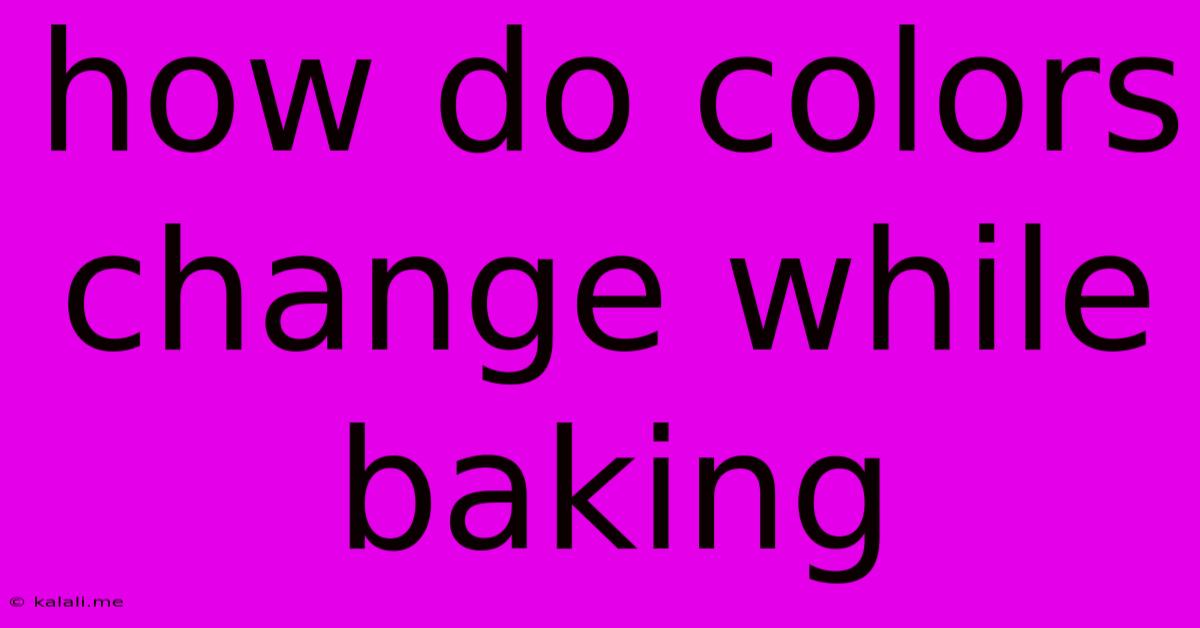How Do Colors Change While Baking
Kalali
May 25, 2025 · 3 min read

Table of Contents
How Colors Change While Baking: A Baker's Guide to Maillard Reactions and More
The transformation of colors during baking is a captivating process, one that's both aesthetically pleasing and indicative of crucial chemical changes within your baked goods. From the golden-brown crust of a perfectly baked loaf to the rich hues of a caramelized crème brûlée, color is a key indicator of flavor and texture. But what exactly causes these stunning shifts? Let's delve into the science behind the changing colors in your baking.
This article will explore the primary chemical reactions responsible for color changes during baking: the Maillard reaction and caramelization. We'll also touch upon the role of ingredients and baking techniques in influencing the final color of your baked goods.
The Maillard Reaction: The Brown Magic
The Maillard reaction is the primary driver behind the browning of many baked goods. This complex chemical process occurs when amino acids (building blocks of proteins) and reducing sugars react at high temperatures (around 140°C or 284°F). This reaction isn't just about color; it's responsible for the development of hundreds of flavor compounds, contributing to the characteristic aroma and taste of baked items.
Key Factors Influencing the Maillard Reaction:
- Temperature: Higher temperatures accelerate the reaction, leading to deeper browning.
- Time: Longer baking times allow more time for the reaction to occur, resulting in more intense color.
- Moisture Content: A slightly lower moisture content generally promotes browning as it concentrates the reactants.
- pH: A slightly alkaline environment (higher pH) can enhance browning.
- Type of Sugar: Different sugars react differently; for example, fructose tends to brown more quickly than glucose.
- Type of Protein: The type and amount of protein in the ingredients also influence the extent and rate of browning.
Caramelization: The Sweet Browning
Caramelization is another crucial process responsible for color changes, particularly in baked goods with high sugar content. This reaction involves the heating of sugars, specifically sucrose, glucose, and fructose, without the presence of amino acids. As sugars heat up, they undergo a series of chemical transformations, resulting in a rich brown color and characteristic caramel flavor.
Factors Affecting Caramelization:
- Temperature: Caramelization begins around 160-170°C (320-338°F). Overheating can lead to burning.
- Time: Similar to the Maillard reaction, longer heating times deepen the color and intensify the flavor.
- Type of Sugar: Different sugars caramelize at slightly different temperatures and rates.
- Moisture Content: Similar to the Maillard reaction, lower moisture content generally results in more efficient caramelization.
Beyond the Basics: Other Factors Affecting Color
Several other factors can subtly influence the color of your baked goods:
- Ingredients: The use of specific ingredients like cocoa powder, spices (cinnamon, nutmeg), or fruit purees can naturally influence the final color.
- Baking Techniques: Techniques like using steam injection during baking can impact crust color and texture.
- Oven Type and Calibration: Different ovens might have varying temperature distributions, leading to variations in browning.
Conclusion: Mastering the Art of Color
Understanding the interplay of the Maillard reaction and caramelization is key to achieving the perfect color in your baking. By carefully controlling factors like temperature, time, and ingredient choices, you can fine-tune the browning process and create visually appealing and delicious baked goods. Remember, practice and experimentation are essential for mastering the art of color in baking. Keep experimenting with different recipes and techniques to observe how variations in ingredients and methods affect the final color and flavor profile of your creations.
Latest Posts
Latest Posts
-
How Do You Cut Hardie Board
May 26, 2025
-
How Often Do Rotors Need To Be Replaced
May 26, 2025
-
How To Get Cheese To Stick To Pizza
May 26, 2025
-
Sending Opensource Code To Send Potential Employeer Sample Code
May 26, 2025
-
How To Install A Tankless Hot Water Heater
May 26, 2025
Related Post
Thank you for visiting our website which covers about How Do Colors Change While Baking . We hope the information provided has been useful to you. Feel free to contact us if you have any questions or need further assistance. See you next time and don't miss to bookmark.